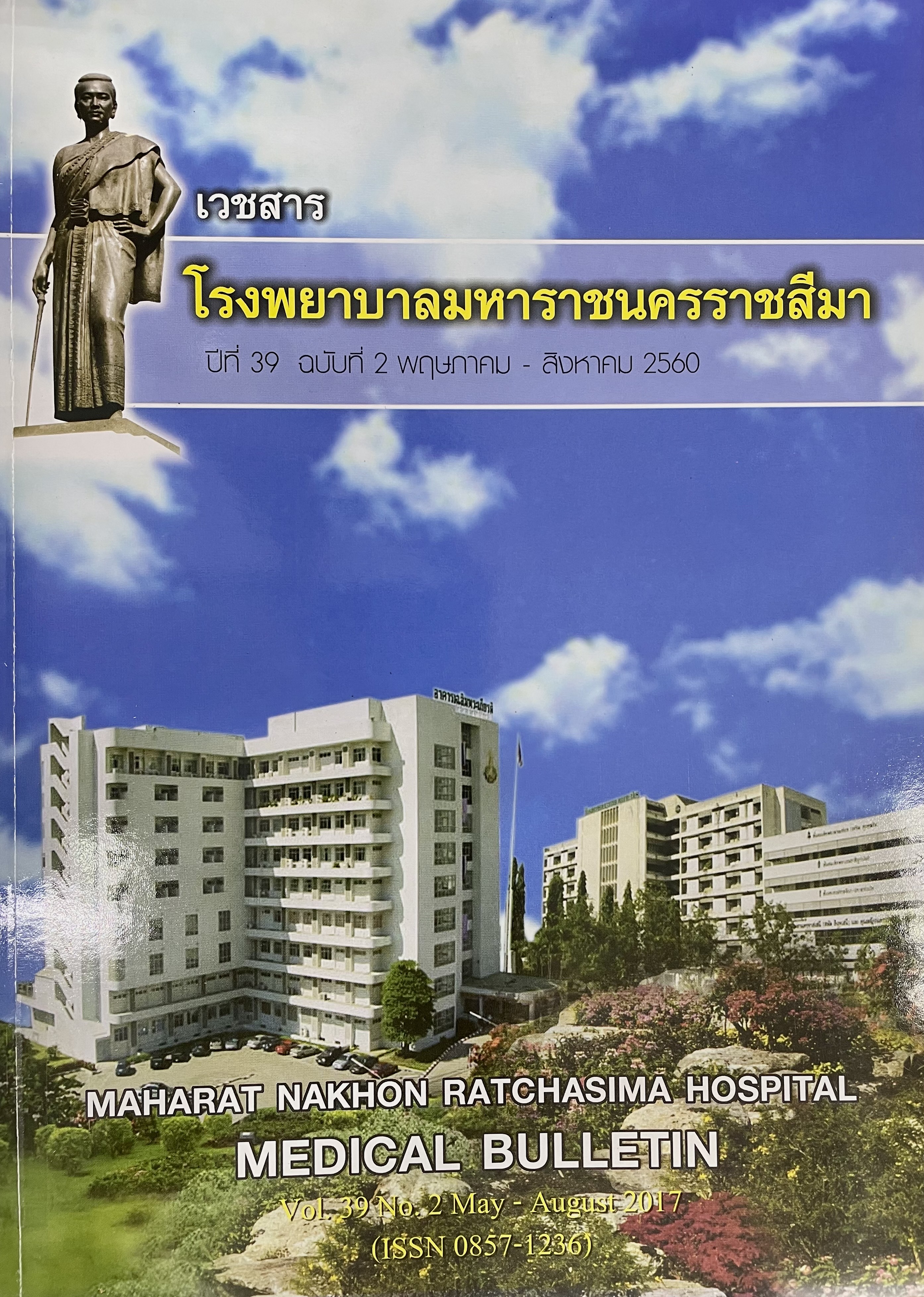ผลการรักษาด้วยการฉีด Bevacizumab เข้าน้ำวุ้นตา ในส่วนของ Visual outcome และ Morphologic outcome ผู้ป่วยที่มีจอประสาทตาบวมจากเบาหวาน ที่มีลักษณะที่แตกต่างกันจากการตรวจด้วย OCT
Main Article Content
บทคัดย่อ
จุดประสงค์: เพื่อประเมินประสิทธิผลในการรักษาด้วยการฉีด bevacizumab เข้านํ้าวุ้นตาทั้งส่วนของ visual outcome และ morphologic outcome ต่อผู้ป่วยที่มีจอประสาทตาบวมจากเบาหวานที่มีลักษณะที่แตกต่างกันจากการตรวจด้วย optical coherence tomography (OCT) ที่ระยะเวลา 6 เดือน ระเบียบวิธีวิจัย: การวิจัยแบบretrospective comparative study ในผู้ป่วยเบาหวานชนิดที่ 2 ที่ได้รับการวินิจฉัยเป็น จอประสาทตาบวมจากเบาหวาน (diabetic macular edema) จำนวน 64 ดวงตา โดยแบ่งชนิดของ DME ตามลักษณะที่พบใน OCT เป็น diffuse retinal thickening (DRT), cystoid macular edema (CME) และ serous retinal detachment (SRD) ผู้ป่วยทุกคน ได้รับการฉีด bevacizumab เข้าน้ำวุ้นตาเดือนละครั้ง จำนวน 3 ครั้ง จากนั้นรับการฉีดตามความจำเป็น (as-needed regimen) ผู้วิจัยติดตามข้อมูลผลการวัดการมองเห็น (best corrected visual acuity) จากเวชระเบียน และผลภาพถ่าย OCT เพื่อประเมินความหนาจุดรับภาพ (central foveal thickness) หลังจากฉีดยาเข็มแรกแล้วจนถึง 6 เดือน ผลการศึกษา: ในจำนวน 64 ดวงตา ที่วินิจฉัยเป็นจอประสาทตาบวมจากเบาหวานมี 24 ดวงตา (37.5%) เป็นชนิด DRT, 21 ดวงตา (32.8%) เป็นชนิด CME และ 19 ดวงตา (29.7%) เป็นชนิด SRD โดยไม่พบความแตกต่างของการมองเห็น (BCVA) และความหนาจุดรับภาพ (CFT) ระหว่างทั้งสามชนิดของ DME (P =0.875 และ 0.294 ตามลำดับ) หลังจากรับการรักษาด้วยการฉีด bevacizumab เข้าน้ำวุ้นตาเป็นเวลา 6 เดือน พบว่าการมองเห็นดีขึ้นอย่างมีนัยสำคัญทางสถิติ (P<0.001) และความหนาจุดรับภาพลดลงอย่างมีนัยสำคัญทางสถิติ (P<0.001) ในจอประสาทตาบวมจากเบาหวานทั้งสามชนิด โดยไม่พบความแตกต่างกันอย่างมีนัยสำคัญทางสถิติทั้งในส่วนของผลการมองเห็นที่ดีขึ้น (P=0.220) และความหนาจุดรับภาพที่ลดลง (P=0.635) ระหว่างกลุ่ม อย่างไรก็ตามพบว่า จอประสาทตาบวมจากเบาหวานชนิด DRT ได้รับผลการรักษาที่ดีกว่าชนิดอื่นเล็กน้อย สรุป: การรักษาด้วยการฉีด Bevacizumab เข้าน้ำวุ้นตาสามารถให้ผลการมองเห็นที่ดีขึ้น และความหนาจุดรับภาพที่ลดลงได้ในภาวะจอประสาทตาบวมจากเบาหวานทั้งสามชนิดที่แตกต่างกันจากการตรวจ OCT ในช่วง 6 เดือนหลังการรักษา
Article Details

อนุญาตภายใต้เงื่อนไข Creative Commons Attribution-NonCommercial-NoDerivatives 4.0 International License.
เอกสารอ้างอิง
Early Treatment Diabetic Retinopathy Study Research Group. Photocoagulation for diabetic macular edema, report #1. Arch Ophthalmol 1985; 103: 1796-806.
Klein R, Klein BE, Moss SE. Visual impairment in diabetes. Ophthalmol 1984; 91: 1-9.
Antonetti DA, Klein R, Gardner TW. Diabetic retinopathy. N Engl J Med 2012; 366: 1227-39.
Chen E, Looman M, Laouri M, Gallagher M, Van Nuys K, Lakdawalla D, et al. Burden of illness of diabetic macular edema: literature review. Curr Med Res Opin 2010; 26: 1587-97.
Ma JX, Zhang SX, Wang JJ. Down-regulation of angiogenic inhibitors: a potential pathogenic mechanism for diabetic complications. Curr Diabetes Rev 2005; 1: 183-96.
Otani T, Kishi S, Maruyama Y. Patterns of diabetic macular edema with optical coherence tomography. Am J Ophthalmol 1999; 127: 688-93.
Antcliff RJ, Marshall J. The pathogenesis of edema in diabetic maculopathy. Semin Ophthamol 1999; 14: 223-32.
Aiello LP. Vascular endothelial growth factor and the eye: biochemical mechanisms of action and implications for novel therapies. Ophthalmic Res 1997; 29: 354-62.
Arevalo JF, Fromow-Guerra J, Quiroz-Mercado H, Sanchez JG, Wu L, Maima M, et al. Primary intravitreal bevacizumab (Avastin) for diabetic macular edema. Ophthalmol 2007; 114: 743-50.
Haritoglou C, Kook D, Neubauer A, Wolf A, Priglinger S, Strauss R, et al. Intravitreal Bevacizumab (Avastin) therapy for persistant diffuse diabetic macular edema. Retina 2006; 26: 999-1005.
Masahiko S, Kanako Y, Masayuki Y, Toru N. Visual outcome after intravitreal Bevacizumab depends on the optical coherence tomographic patterns of patients with diffuse diabetic macular edema. Retina 2013; 33: 740-7.
Wu PC, Lai CH, Chen CL, Kuo CN. Optical coherence tomographic patterns in diabetic macula edema can predict the effects of intravitreal bevazicumab injection as primary treatment. J Ocul Pharmacol Ther 2012; 28: 59-64.
Kim M, Lee P, Kim Y, Yu SY, Kwak HW. Effect of intravitreal Bevacizumab based on optical coherence tomography patterns of diabetic macular edema. Ophthalmologica 2011; 226: 138-44.
Seo KH, Yu SY, Kim M, Kwak HW. Visual and morphologic outcomes of intravitreal ranibizumab for diabetic macular edema based on optical coherence tomography patterns. Retina 2016; 36: 588-95.
Elman MJ, Bressler NM, Qin H, Beck RW, Ferris FL, Friedman SM, et al. Expanded 2-year follow-up of ranibizumab plus prompt or deferred laser or triamcinolone plus prompt laser for diabetic macular edema. Ophthalmol 2011; 118: 609-14.
Yamamoto S, Yamamoto T, Hayashi M, Takeuchi S. Morphologic and functional analyses of diabetic macular edema by optical coherence tomography and multifocal electroretinograms. Graefes Arch ClinExp Ophthalmo 2001; 239: 96-101.
Kim BY, Smith SD, Kaiser PK. Optical coherence tomography patterns of diabetic macular edema. Am J Ophthalmol 2006; 142: 405-12.
Alkuraya H, Kangave D, Abu El-Asrar AM. The correlation between optical coherence tomographic features and severity of retinopathy, macular thickness and visual acuity in diabetic macular edema. Int Ophthalmol 2005; 26: 93-9.
Antonetti DA, Barber AJ, Khin S,Lieth E,Tarbell JM, Gardner TW. Vascular permeability in experimental diabetes is associated with reduced endothelial occlusion content: vascular endothelial growth factor decreases occluding in retinal endothelial cells. Penn State Retina Research Group. Diabetes 1998; 47: 1953-9.
Gardner TW, Antonetti DA, Barber AJ, LaNoue KF, Levison SW. Diabetic retinopathy: more than meet the eye. SurvOphthalmol2002; 47: S253-62.
Yanoff M, Fine BS, Brucker AJ, Eagle RC Jr. Pathology of human cystoid macular edema. Surv Ophthalmol 1984; 28: 505-11.
Fine BS, Brucker AJ. Macular edema and Cystoid macular edema. Am J Ophthalmol 1981; 92: 466-81.
Plate KH, Breier G, Weich HA, Rosau W. Vascular endothelial growth factor is the potential tumor angiogenesis factor in human gliomas in vivo. Nature 1992; 359: 845-8.
Shweiki D, Itin A, Soffer D, Keshet E. Vascular endothelial growth factor induced by hypoxia may mediate hypoxia-initiated angiogenesis. Nature 1992: 359: 843-5.
Shimura M, Nakasawa T, Yazuda K, Shiono T, Iida T, Sakamoto T, et al. Comparative therapy evaluation of intravitreal bevacizumab and triamcinolone acetonide on persist diffuse diabetic macular edema. Am J Ophthalmol 2008; 145: 854-61.
Ferris FL III, Patz A. Macular edema: a complication of diabetic retinopathy. Surv Ophthalmol 1984; 28: 452-61.
Kang SW, Park CY, Ham DI. The correlation between fluorescein angiographic and optical coherence tomographic features in clinical significant diabetic macular edema. Am J Ophthalmol 2004; 137: 313-22.

